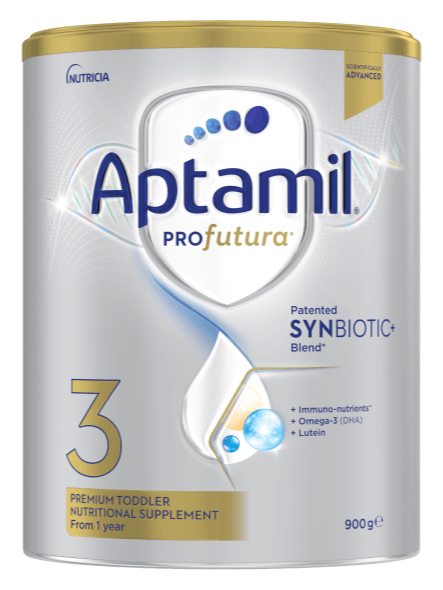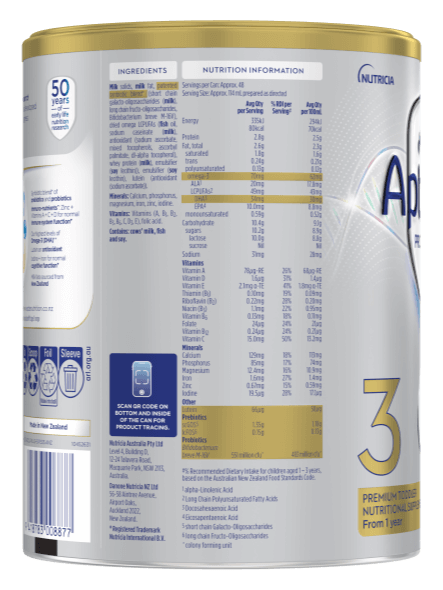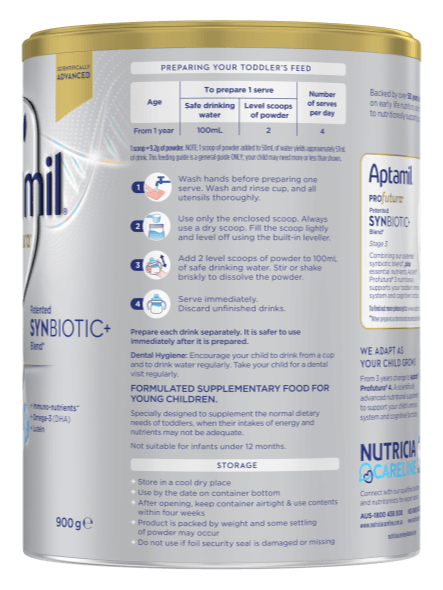



Product Information
A premium toddler nutritional supplement designed to help meet the dietary needs of toddlers from 1 year old whose nutritional intake may not be adequate. It contains no sucrose and is free from artificial colours and flavours.
Features
APTAMIL® PROFUTURA helps build strong foundations for:
Contraindications for use
Confirmed cows’ milk protein allergy, galactosaemia, lactose intolerance. Not suitable before 12 months of age.
Direction of Use
- Wash hands before preparing one serve. Wash and rinse cup and all utensils thoroughly.
- Using the scoop enclosed, fill the scoop lightly and level off using the built-in leveler.
- Add 2 level scoops of powder to 100mL of safe drinking water. For smaller volumes simply add 1 scoop to each 50mL of water. Whisk, shake or stir the mixture briskly to dissolve powder. Serve immediately, or for a cold drink chill in the refrigerator for 1 hour before serving. For a warm drink, heat slightly before serving. Discard unfinished drinks.
Prepare each bottle separately. For all brands of formula, it is safer to use immediately after they are prepared.
Storage
- Store in a cool, dry place.
- Use by the date on bottom of the container.
- After opening, keep container airtight and use contents within four weeks.
- Some settling of the powder may occur.
Feeding Guide
| Age | Cooled boiled water | Level scoops of powder* | Number of feeds per day |
|---|---|---|---|
| From 1 – 3 years | 100ml | 2 | 4 |
*1 scoop = 9.2g of powder. NOTE: 1 scoop of powder added to 50mL of water yields approximately 57mL of formula. This feeding guide is a general guide ONLY; your child may need more or less than shown.
Allergen and Cultural Information
This product contains cows’ milk products, fish and soy.
Nutritional Information
| Average contents | Avg Qty Per Serve | % Daily Intake Per Serve | Per 100ml |
|---|---|---|---|
| NUTRITION INFORMATION | |||
| Energy | 335 kJ | 294 kJ | |
| 80 kcal | 70 kcal | ||
| Protein | 2.8 g | 2.5 g | |
| Carbohydrates | 10.4 g | 9.1 g | |
| Sugars | 10.2 g | 8.9 g | |
| Lactose | 10.0 g | 8.8 g | |
| Total Fat | 2.6 g | 2.3 g | |
| Saturated fatty acid | 1.8 g | 1.6 g | |
| Monounsaturated fatty acid | 0.59 g | 0.52 g | |
| Polyunsaturated fatty acid | 0.13 g | 0.12 g | |
| Transaturated fatty acid | 0.24 g | 0.21 g | |
| Total Omega 3(incl ALA) | 70 mg | 62 mg | |
| — ALA a | 20 mg | 17.8 mg | |
| — LCPUFAs b | 49 mg | 43 mg | |
| — DHA c | 34 mg | 30 mg | |
| — EPA d | 10.0 mg | 8.8 mg | |
| MINERALS | |||
| Calcium | 129 mg | 18 % | 113 mg |
| Phosphorus | 85 mg | 17 % | 74 mg |
| Sodium | 32 mg | 28 mg | |
| 1.4 mmol | 1.2 mmol | ||
| Magnesium | 12.4 mg | 16 % | 10.9 mg |
| Iron | 1.6 mg | 27 % | 1.4 mg |
| Zinc | 0.67 mg | 15 % | 0.59 mg |
| Iodine | 19.5 μg | 28 % | 17.1 μg |
| VITAMINS | |||
| Vitamin A | 78 ug-RE | 26 % | 68 μg-RE |
| Vitamin D | 1.6 μg | 31 % | 1.4 μg |
| Vitamin E | 2.1 mg | 41 % | 1.8 mg |
| Thiamin (B~1~) | 0.1 mg | 19 % | 0.09 mg |
| Vitamin B~2~ | 0.22 mg | 28 % | 0.20 mg |
| Vitamin B~6~ | 0.13 mg | 18 % | 0.11 mg |
| Vitamin B~12~ | 0.24 μg | 24 % | 0.21 μg |
| Niacin (B~3~) | 1.1 mg | 22 % | 0.95 mg |
| Folate | 24 μg | 24 % | 21 μg |
| Vitamin C | 15.0 mg | 50 % | 13.2 mg |
| OTHER | |||
| Lutein | 66 μg | 58 μg | |
| PREBIOTICS | |||
| ScGOS ^ | 1.35 g | 1.18 g | 1.18 g |
| lcFOS ^^ | 0.15 g | 0.13 g | 0.13 g |
| PROBIOTICS | |||
| Bifidobacterium breve M16-V | 551 milion cfu | 483 milion cfu | |
| *Daily intake per serve is based on the recommended dietary intake for children aged 1 – 3 years |
Ingredients
Milk solids, milk fat, short chain galacto-oligosaccharides (contains milk), dried omega LCPUFAs (contains fish, milk, emulsifier (soy lecithin), antioxidant (sodium ascorbate, mixed tocopherols, ascorbyl palmitate, di-alpha tocopherol)), long chain fructo-oligosaccharides, maltodextrin, emulsifier (soy lecithin), Bifidobacterium breve M-16V.
References
- Chatchatee P et al. 2012, 4th World Congr of Paed, Gastro, Hepa and Nutr. 2. Koletzko B et al. J Perinat Med 2008; 36:5–14. 3. Birch et al. Am J Clin Nutr 2010; 91:848–859. 4. Innis S et al. J Pediatr Gastroenterol Nutr 2009; 48:S16–S24.
